
Pseudothyatira is a monotypic moth genus of the family Drepanidae first described by Augustus Radcliffe Grote in 1864. Its only species, Pseudothyatira cymatophoroides, the tufted thyatirid moth, was first described by Achille Guenée in 1852. It is found in North America in Newfoundland, British Columbia, northern California, Maryland, West Virginia, Kansas and North Carolina.

Chytolita is a monotypic litter moth genus of the family Erebidae erected by Augustus Radcliffe Grote in 1873. Its only species, Chytolita morbidalis, the morbid owlet moth or morbid owlet, was first described by Achille Guenée in 1854. It is found in large parts of North America, from coast to coast in the north and south to North Carolina, Texas and Florida in the west. The habitat consists of deciduous woods and edges.

Abagrotis mirabilis is a moth of the family Noctuidae first described by Augustus Radcliffe Grote in 1879. It is found in western North America, from British Columbia south to California.
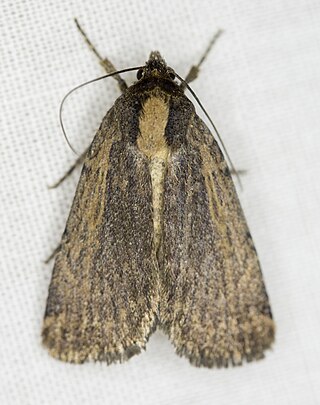
Abagrotis nanalis is a moth of the family Noctuidae first described by Augustus Radcliffe Grote in 1881. It is found in North America from southern British Columbia east to southwest Saskatchewan and western North Dakota, south to northern New Mexico and California.
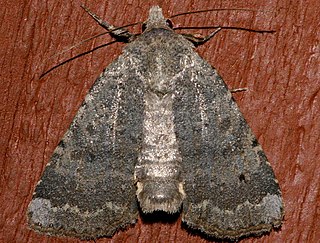
Abagrotis variata is a moth of the family Noctuidae first described by Augustus Radcliffe Grote in 1876. It is found in North America from British Columbia to California, east to New Mexico and Alberta.

Alypia ridingsii, the mountain forester or Ridings' forester, is a moth of the family Noctuidae. The species was first described by Augustus Radcliffe Grote in 1864. It is found in North America as far east as the eastern edge of the Rocky Mountains in Colorado. It is also found in Arizona, Utah, all of California and northward into Oregon, Idaho, Washington, British Columbia and Alaska

Andropolia aedon is a moth in the family Noctuidae first described by Augustus Radcliffe Grote in 1880. It is found in North America from British Columbia and Alberta south to California.

Globia oblonga, the oblong sedge borer, is a moth of the family Noctuidae. The species was first described by Augustus Radcliffe Grote in 1882. It is found in parts of Canada and the United States
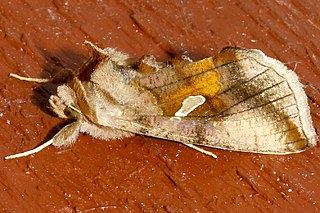
Autographa metallica, the shaded gold spot, is a moth of the family Noctuidae. The species was first described by Augustus Radcliffe Grote in 1875. It is found in western North America from the southern Alaska coast and the Queen Charlotte and Vancouver Islands south to central California, east to the Alberta-British Columbia border and south in the Rocky Mountains to central Colorado.

Schinia nuchalis, the spotted sage moth, is a moth of the family Noctuidae. The species was first described by Augustus Radcliffe Grote in 1878. It is found from the Great Plains and Great Basin, from southern Saskatchewan, Alberta and British Columbia south to northern Arizona. The Eurasian Schinia scutosa is no longer considered a synonym of Schinia nuchalis.
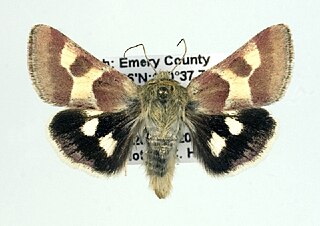
Schinia suetus is a moth of the family Noctuidae first described by Augustus Radcliffe Grote in 1873. It is widespread in the mountains of western North America, from southern Alberta west to British Columbia, south at least to Colorado and California, east to Idaho and New Mexico.

Raphia frater, the brother moth or simply the brother, is a moth of the family Noctuidae. It is found from Nova Scotia west, across the forested regions of Canada to British Columbia, south to Mississippi in the east. The southern limits in the west are uncertain due to confusion with several closely related species or forms.

Drasteria adumbrata, the shadowy arches, is a moth of the family Erebidae. The species was first described by Hans Hermann Behr in 1870. It is found from coast to coast in southern Canada, south in the west to California and Colorado, south in the east to New England and Michigan. Subspecies D. a. alleni is found from eastern Alberta to New York and Nova Scotia. Subspecies D. a. saxea occurs from southern British Columbia and south-west Alberta south to California and Colorado.
Euxoa cicatricosa is a moth of the family Noctuidae first described by Augustus Radcliffe Grote and Coleman Townsend Robinson in 1865. It is found in North America from south central Saskatchewan west to southern interior British Columbia; south to southern California, Arizona, New Mexico and western Texas; east to western Nebraska and North Dakota.

Gnophaela vermiculata, sometimes known as the police-car moth or green lattice, is a moth of the family Erebidae. The species was first described by Augustus Radcliffe Grote in 1864. It is found in the Rocky Mountain region of the United States and in western parts of North America, from British Columbia to California, east to New Mexico and north to Manitoba.

Dioryctria auranticella, the ponderosa pineconeworm moth, is a moth of the family Pyralidae. The species was first described by Augustus Radcliffe Grote in 1883. It is found in western North America from southern British Columbia south to California and Arizona, east to South Dakota and New Mexico.

Synchlora aerata, the wavy-lined emerald moth or camouflaged looper, is a species of moth of the family Geometridae. The species was described by Johan Christian Fabricius in 1798. It is found in the United States and Canada.
Agriphila attenuata is a moth in the family Crambidae. It was described by Augustus Radcliffe Grote in 1880. It is found in North America, where it has been recorded from coastal California, Washington, Wyoming, British Columbia and Alberta. The habitat consists of grasslands.

Pyrausta nicalis is a moth in the family Crambidae. It was described by Augustus Radcliffe Grote in 1878. It is found in North America, where it has been recorded from Quebec west to British Columbia, south to Colorado, Utah, Nevada and California.
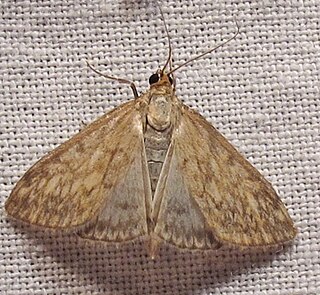
Sitochroa chortalis, the dimorphic sitochroa moth, is a moth in the family Crambidae. It was described by Augustus Radcliffe Grote in 1873. It is found in North America, where it has been recorded from Nova Scotia to southern British Columbia, south to New Jersey, Arizona and northern California. The habitat consists of grassland and prairie areas.

















